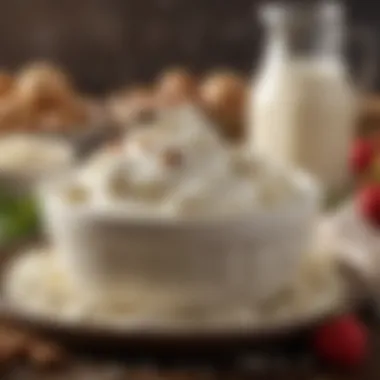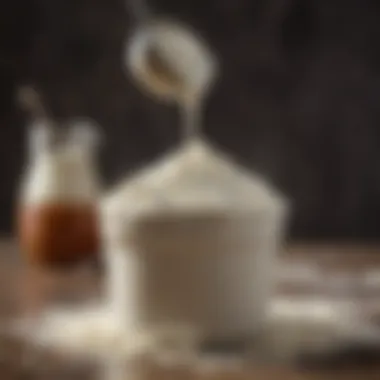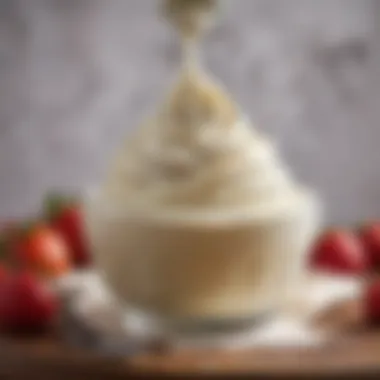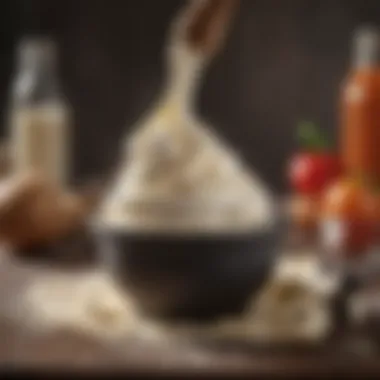Essential Ingredients for Homemade Whipping Cream


Intro
Creating homemade whipping cream can elevate any dessert. It gives a personal touch that pre-packaged options often lack. Understanding the core ingredients behind this versatile concoction is crucial for achieving the desired texture and flavor. This guide will provide a detailed overview of everything required to make whipping cream, exploring each ingredient's role and highlighting useful tips for home cooks of every skill level.
Recipe Overview
Recipe Name
Homemade Whipping Cream
Description of the Dish
Homemade whipping cream offers a rich and creamy addition to cakes, pies, and other desserts. Unlike store-bought varieties, it can be tailored to your taste, offering options for sweetness and flavor. By mastering this simple process, cooks can transform any dish into a decadent treat.
Ingredients
List of Ingredients with Measurements
- Heavy Cream (1 cup): This is the primary ingredient known for its high fat content, necessary for achieving stability and volume when whipped.
- Granulated Sugar (2 tablespoons): Sugar sweetens the cream and affects texture; it should be adjusted to personal preference.
- Vanilla Extract (1 teaspoon): This adds a pleasing aromatic note that enhances flavor. You may substitute it with almond extract for a different profile.
- Salt (a pinch): A small amount of salt can balance the sweetness and improve overall flavor.
Special Notes on Ingredients
- Heavy Cream: Ensure you use heavy cream, as lighter creams won’t whip correctly. Look for options labeled "heavy whipping cream" in stores.
- Sugar: For healthier alternatives, consider using powdered sugar, which dissolves quickly.
- Flavor Variations: You can customize your whip by adding flavors like cocoa powder, coffee essence, or even citrus zests to the mixture.
Keep in mind: Homemade whipping cream is best when used fresh. If you have leftovers, store them in an airtight container for up to two days in the refrigerator.
Preamble to Homemade Whipping Cream
Making homemade whipping cream is not only a delightful endeavor but also an essential skill for any culinary enthusiast. Whipping cream serves as a versatile ingredient, elevating a wide range of desserts and dishes. Understanding the basics of how to create it can lead to more satisfying results in your cooking and baking.
Defining Whipping Cream
Whipping cream is a light, airy dairy product made by whipping certain fats found in cream. It is typically produced from the high-fat content of fresh milk. When whipped, it undergoes a transformation, incorporating air and increasing in volume. The result is a creamy texture that can be used in various applications, from toppings to fillings. The cream must contain at least 30% butterfat for it to whip properly, as this richness is crucial for achieving the desired consistency and stability in the final product.
Importance of Quality Ingredients
The ingredients used in making whipping cream can greatly influence the final product. High-quality ingredients lead to more flavorful and stable whipping cream. The choice of heavy cream, sugar, and flavorings must not be taken lightly. As the old saying goes, "you get what you pay for," particularly rings true in this context.
- Heavy Cream: Opting for a product with a higher fat content ensures better whipping results.
- Granulated Sugar: The right type and amount of sugar enhance the taste without overpowering it.
- Flavorings: Ingredients like vanilla extract can significantly improve the sensory experience of the cream.
Investing in quality ingredients not only improves the taste of your homemade whipping cream but also contributes to its texture and performance. The proper selection will provide a superior base for countless recipes.
Essential Ingredients for Whipping Cream
Homemade whipping cream can elevate a dish, transforming simple desserts into remarkable treats. Understanding the essential ingredients is vital for achieving that perfect texture and flavor. Each component plays a unique role, affecting the final outcome of the whipped cream. High-quality ingredients yield a superior product, making the whipping process smoother and more effective.
Heavy Cream: The Base Ingredient
Composition and Fat Content
Heavy cream is the cornerstone of whipping cream. With a fat content ranging between 36% and 40%, it can hold air effectively when whipped. This fat content is crucial because it supports the structure and stability of the cream as it is aerated. A higher fat content typically results in a richer and creamier texture.
People prefer heavy cream largely because it produces a denser and more opulent end result. Therefore, choosing heavy cream with the right composition can significantly influence the quality of your whipping cream. Lower fat alternatives will not whip properly and can lead to disappointment.
Choosing the Right Heavy Cream
When selecting heavy cream, look closely at the ingredient list. Ideally, it should contain only milk and cream. Some brands introduce stabilizers, which may impact the whipping ability. Opt for organic or fresh cream for better flavor and quality. Freshness is imperative; older cream can affect the taste and whipping efficiency.
Different regions may have varying brands that perform adequately. The right heavy cream can make all the difference in getting that perfect sweet peak formation.
Brands and Recommendations


Certain brands consistently receive high praise for their whipping cream quality. Brands like Horizon Organic, Land O'Lakes, and Organic Valley are popular choices among home cooks. Their products often have a reliable fat content and minimal additives. Each brand may have subtle taste differences, and experimentation can lead to discovering personal preferences.
Another important factor is price. In many cases, higher quality equates to a higher cost, but some budget-friendly options can perform equally well. It's wise to be open to trying lesser-known brands to find the best fit.
Granulated Sugar: Sweetening the Cream
Sugar vs. Confectioners’ Sugar
Sugar serves a critical role in sweetening the whipped cream. Granulated sugar is the most common choice for flavoring. It dissolves well; however, it requires thorough whipping to ensure it blends in completely. Confectioners’ sugar is another option, containing cornstarch that aids in stabilization. This can offer a smoother texture but may change flavor slightly.
Choosing between these sugars depends on personal preference. For a straightforward sweet taste, granulated sugar suffices well. The choice also matters for specific recipes seeking a particular texture or flavor profile. Ultimately, taste tests can guide personal decisions here.
Alternative Sweeteners
For those concerned with sugar intake, alternative sweeteners like erythritol, monk fruit, or agave syrup exist. Each of these sweeteners brings unique characteristics. Some fully dissolve in whipped cream without contributing calories, while others might alter flavor minimally. Choosing the right alternative depends on dietary needs and flavor preferences.
However, it is wise to test these substitutes, as their sweetness levels can differ significantly from regular sugar. Careful adjustments to proportions are necessary to find the ideal sweetness level.
Proportions for Ideal Sweetness
Determining the correct amount of sugar to incorporate facilitates balance in flavor. A common proportion is about two tablespoons of sugar per cup of heavy cream. However, preferences vary, prompting some to adjust upwards or downwards. Testing recipes and adjusting sweetness gradually can help pinpoint the desired balance.
Every palate is unique. Perhaps some prefer a less sweet version, while others love richer flavors. When in doubt, start cautiously and build up the sweetness, ensuring that the whipped cream remains well-balanced and harmonious with other components in the dish.
Vanilla Extract: Flavoring the Cream
Types of Vanilla Extract
Vanilla extract is indispensible. There are various types: pure vanilla extract, imitation vanilla, and vanilla bean paste. Pure vanilla extract, made from real vanilla beans, delivers a rich flavor. Imitation vanilla is often less expensive but may lack complexity.
When flavoring whipped cream, the choice of vanilla type significantly influences the final taste. Pure options yield the most authentic experience, which is generally preferred by those who value quality in their culinary pursuits.
Homemade Vanilla Extract Options
Making homemade vanilla extract enhances flavor even further. Using high-quality vodka and vanilla beans, this can infuse and improve over time. Such an approach also allows personal tailoring to one’s taste, producing a distinct flavor.
The benefit of homemade extract lies in the control over the ingredients. It often yields a fresher flavor compared to store-bought options. However, it requires time to mature and is not instant, which may be a downside for those seeking immediate results.
Substitutes for Flavoring
If vanilla is unavailable, various substitutes can also serve. Almond extract or different flavorings can complement whipped cream without dominating the overall flavor profile. However, it's essential to use sparingly, as these substitutes can be more potent than vanilla.
Experimenting with substitutes enables creativity in the kitchen. These swaps can lead to interesting and delightful flavor combinations that might surprise even seasoned culinary enthusiasts.
Optional Ingredients for Enhanced Flavor
When crafting homemade whipping cream, the foundational ingredients like heavy cream, sugar, and vanilla are essential. However, the use of optional ingredients for enhanced flavor can elevate this basic recipe into a luxurious dessert experience. These add-ins not only provide rich layers of taste but also allow for a degree of customization to suit various preferences. Incorporating additional flavors can transform simple whipped cream from a mere topping into a standout component of many dishes.
Chocolate or Cocoa Powder
Chocolate or cocoa powder is a popular choice for enhancing the flavor of whipping cream. The richness of chocolate can add depth and indulgence, making it an ideal pairing for desserts such as cakes, pies, or even coffee. Depending on the type of cocoa powder used, you can achieve varying intensity levels in the flavor profile. More intense flavors can be created with dark cocoa powder, while a lighter, more mellow taste can result from using milk chocolate powder.
When using chocolate, ensure to sift the powder before adding it to the cream. This helps avoid clumps that can disrupt the smooth texture of the finished product. As a guideline, start with about a tablespoon of cocoa powder for every cup of heavy cream, adjusting according to your taste preference. Experimentation here can yield delightful results, aligning with personal preferences.
Coffee: A Rich Addition
Coffee is another exceptional ingredient to consider when enhancing the flavor of homemade whipping cream. The bitterness of coffee can balance the sweetness of the cream, providing a sophisticated flavor profile. This can be particularly effective in desserts such as tiramisu or as a topping for coffee beverages.
To incorporate coffee into your whipping cream, start by brewing a strong espresso or coffee and allowing it to cool. Use a measured amount, typically around two tablespoons per cup of cream, to maintain a good balance of taste. Make sure to add it into the cream gradually during the whipping process to achieve a uniform consistency. Care should be taken not to add too much liquid, as excess moisture can affect the ability of the cream to whip effectively.
Nut Extracts: Variations in Flavor


Nut extracts are versatile enhancers that can add a unique twist to your whipping cream. They offer a reasonably concentrated flavor without the need for additional volume, making them ideal for those wanting a distinct taste without changing the texture.
Almond Extract
Almond extract is particularly noteworthy for its aromatic qualities, making it a popular choice for flavoring whipped cream. With its distinct nutty and sweet notes, almond extract can complement desserts like fruit tarts or even chocolate cakes effectively. It is crucial to use it sparingly due to its intense flavor; a few drops or a half teaspoon per cup of cream is often sufficient.
One of the advantages of using almond extract is its easy availability and the depth of flavor it creates without the need for actual nuts. However, individuals with nut allergies should avoid this ingredient altogether.
Other Nut Extract Options
Beyond almond, other nut extracts can also enhance the flavor profile of whipping cream. Options like hazelnut, pecan, or walnut extract can introduce varying degrees of richness and warmth to your recipes. Each has a unique flavor characteristic that can enhance desserts in distinct ways.
For example, hazelnut extract, with its bold and slightly earthy taste, works well in chocolate desserts. The amounts used are similar to almond extract, generally a few drops or a small spoonful based on personal preference.
On the downside, nut extracts, like almond, should be used judiciously due to the potential for strong overpowering flavors. Furthermore, nut allergies may restrict the use of many of these flavors, making caution necessary.
Incorporating optional ingredients allows for personalized flavors, enhancing the overall experience of homemade whipping cream.
Preparation Methods
Preparation methods play a crucial role in the quality of homemade whipping cream. The techniques employed can significantly influence the final texture and flavor of the cream. When engaging in this process, understanding various mixing techniques and the temperature of ingredients is vital. Proper methods ensure that each ingredient fulfills its purpose effectively, leading to a superior homemade product.
Mixing Techniques
Using a Stand Mixer
Using a stand mixer is a popular choice for making whipping cream due to its efficiency and consistent results. The stand mixer allows for rapid air incorporation, which aids in achieving the right volume and texture. One key characteristic of this method is its powerful motor, which can handle larger quantities of cream without fatigue.
A stand mixer typically features multiple speeds, allowing users to begin mixing at a slow tempo and gradually increase to achieve desired peaks. This adaptability makes it a beneficial choice for those who wish to avoid the physical effort involved in other techniques.
However, a few disadvantages exist. Firstly, the equipment requires space on the countertop, which may not be suitable in smaller kitchens. Secondly, the initial investment for a good quality stand mixer can be substantial compared to manual methods. Yet, for those who frequently whip cream, its efficiency can outweigh these concerns.
Hand Whipping Techniques
Hand whipping techniques offer an alternative that many home cooks appreciate. This method requires a whisk and some physical effort. One of the key characteristics of hand whipping is the direct control over the mixing speed and strength. This control can lead to more mindful regulation of air incorporation, so cooks can achieve textures according to their preference.
Many find hand whipping an enjoyable process, especially in a social setting, as it encourages interaction. It also allows for minimal equipment, which is accessible to all.
However, the labor-intensive nature of hand whipping can be seen as a disadvantage. It may take significantly longer to reach the desired peaks when compared to using a stand mixer. Additionally, it requires physical stamina and can lead to fatigue especially if a large volume of cream is being prepared. Thus, while hand whipping brings certain advantages in terms of control and ease of access, it may not be suitable for everyone.
Optimal Temperature for Ingredients
The temperature of the ingredients is another critical factor in preparing whipped cream. Heavy cream, for example, should be chilled prior to whipping. Cold cream whips better and helps maintain its structure longer than cream at room temperature. Ideal temperatures typically hover around 40°F (4°C) or lower.
When ingredients are at the correct temperature, the fat molecules in the cream are more likely to stabilize around the air bubbles created during whipping. This results in a cream that maintains its shape and texture better. Similarly, storage items like bowls and whisks can also benefit from chilling. Cold surfaces can keep the cream cool as you mix, further enhancing the whipping process.
In summary, mastering these preparation methods is essential for creating homemade whipping cream that impresses in both texture and flavor. Through the combination of efficient mixing techniques and optimal ingredient temperatures, cooks can elevate their culinary attempts.
Tips for Successful Whipping Cream
In preparing homemade whipping cream, several factors determine the quality of the final product. Understanding these elements can lead to consistent results suited for various culinary applications. This section discusses how to achieve the right consistency, prevent common pitfalls, and ensure the best outcome with your whipping cream.
Achieving the Right Consistency
Creating the perfect texture is vital when making whipping cream. The cream's consistency can drastically affect its use in different recipes. Knowing the difference between soft peaks and stiff peaks can help refine your skill in this area.
Soft Peaks vs. Stiff Peaks
Soft peaks occur when the whipping cream is beaten to a point where it holds a gentle shape, but the tip droops. This stage is optimal for folding into other ingredients, like a mousse or cake batter, as it ensures lightness and airiness.
Stiff peaks, on the other hand, are reached when the cream holds its shape firmly. This texture is ideal for topping desserts or for use as a filling in pastries. Utilizing stiff peaks allows for more structure, ensuring your whipped cream maintains form longer.


The choice between soft and stiff peaks largely depends on your intended use of the cream. When whisking, monitor the consistency closely to achieve the desired results.
Avoiding Common Pitfalls
Whipping cream can be tricky if you don’t watch out for some common issues. Knowing how to manage these challenges will maximize the quality of your cream and save you from frustrations.
Preventing Over-Whipping
Over-whipping is a frequent mistake that can turn your cream from a silky delight into an unappetizing butter. When the cream is whipped past the stiff peak stage, the fat molecules begin to clump, leaving behind a grainy texture. This can not only spoil the cream but also waste ingredients and effort. Aim for a balance; stop whipping when the peaks are stiff yet smooth.
Addressing Issues with Separation
Sometimes, even appropriately whipped cream can separate if left too long or stored improperly. Separation occurs when water and fat no longer emulsify, leading to a curdled appearance. To combat this, ensure your cream is kept chilled before use and served soon after whipping. If separation has occurred, re-whipping gently might help restore some structure. Take caution not to over-whip this time, as it can further degrade the texture.
Consider using a stabilizer such as gelatin or cornstarch if you need your whipping cream to hold its shape over extended periods.
In summary, understanding the essential tips for successful whipping cream making can significantly enhance your culinary capabilities. Seek to master the techniques discussed to create a versatile and delightful product suited for various recipes.
Storing and Using Homemade Whipping Cream
Storing and using homemade whipping cream is essential to maintain its quality and extend its shelf life. Proper storage affects not only the taste and texture but also the safety of the product. This section will cover safe storage methods and innovative uses.
Storage Guidelines
Refrigeration Tips
Refrigerating homemade whipping cream is the most common method of storage. Keeping whipping cream in the fridge helps maintain its freshness and prevents spoilage. Place the cream in an airtight container. This minimizes exposure to air and prevents it from absorbing odors from other foods in the fridge. It is best to consume refrigerated whipping cream within 3 to 5 days for optimal taste and quality. The key characteristic of refrigeration is the retention of texture and flavor, making it a beneficial choice for those anticipating use shortly after preparation.
A unique feature of refrigeration is that it allows the cream to be whipped again if it has softened, maintaining its versatility. Although refrigeration is convenient, be aware that the cream can separate after a few days, requiring a light re-whipping to restore smoothness.
Freezing Options and Best Practices
Freezing whipping cream is another option for those who want to extend its life beyond a few days. This method is ideal for long-term storage. When freezing, it can be effective to pour small portions of whipped cream into ice cube trays or freezer bags. This allows for quick usage when needed for recipes. The key characteristic of freezing is the extended shelf life, making it a favorable choice if you have extra cream on hand.
One advantage of this method is that you can thaw exactly the amount required for a dish or dessert. However, texture can slightly change after thawing. Unwhipped cream tends to fare better when frozen compared to whipped. After thawing, it may require re-whipping for reaching desired consistency, which means it's best used in recipes where presence of perfect peaks is not a priority.
Creative Uses for Whipping Cream
Pairing with Desserts
Whipping cream enhances desserts by adding richness and a luscious texture. It complements a wide array of sweets, from cakes to fruit salads. This versatility is a key characteristic that makes it a popular ingredient in desserts. Whether dolloped on top of a slice of pie or folded into cake batters, it elevates the overall experience.
A unique feature is its ability to balance sweeter flavors. Whipping cream helps ease the richness of desserts, making them more enjoyable. However, it is important to add the correct amount to avoid overpowering the other flavors.
Adding to Beverages
Incorporating whipped cream into beverages introduces a creamy element and can transform an ordinary drink into a decadent delight. It is often used in coffee drinks, hot chocolates, and milkshakes. This adds both visual appeal and a smooth texture, which enhances the sensory experience. The key characteristic of adding whipping cream to beverages is the delightful contrast it creates against various flavors, making it a favored choice among drink enthusiasts.
Whipping cream can also be flavored or sweetened before adding to beverages. However, consider the balance of sweetness when deciding to incorporate it. Using too much can make the drink overly rich, possibly overshadowing other components.
Important Note: Always check the freshness of whipped cream before use, regardless of storage method.
Ending
In wrapping up the discussion on homemade whipping cream, it becomes evident how critical the right ingredients are in achieving the desired quality. The use of heavy cream, granulated sugar, and vanilla extract as foundational components defines not only the taste but also the texture of the final product. Additionally, understanding the optional ingredients and their potential to elevate flavor can make a notable difference in culinary applications.
Summary of Key Points
Throughout this guide, several key points have been highlighted:
- Quality of Heavy Cream: Selecting a high-fat content heavy cream is essential. This is the base that supports the structure and creaminess of whipped cream.
- Sugar's Role: Granulated sugar is optimal for sweetness, and its properties affect the overall texture. Finding the right type and amount is vital for perfect balance.
- Enhancements: Optional ingredients such as cocoa powder or nut extracts can introduce variations that personalize your whipping cream to match different desserts or dishes.
- Preparation Techniques: Knowing methods for mixing and the importance of ingredient temperature contributes directly to the success of whipping cream.
- Storage Tips: Proper storage not only prolongs the freshness but also ensures that the ideal flavor and texture are preserved until use.
Encouragement for Culinary Exploration
As you delve into creating your own whipping cream, it's important to embrace experimentation. The beauty of cooking lies in personalization. Adjust ratios, try different flavor extracts, or explore various optional additions. This will not only appeal to your palate but also refine your skills in the kitchen.
Feel empowered to try new combinations. Maybe a splash of coffee or a hint of almond will complement your favorite dessert. As you explore, remember that the pursuit of culinary excellence is a journey, not a destination. Seek out resources, learn from experiences, and continue evolving your craft. The world of homemade whipping cream is wide and filled with delightful possibilities.







